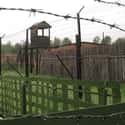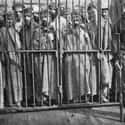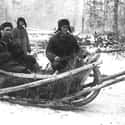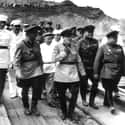(#3) Arrests and Deportations To The Camps Occurred Everywhere, All The Time
The long journey that led to incarceration in a Gulag prison camp began with arrests almost anywhere and for reasons that ranged from the offensive to the outright absurd.
Descriptions from camp survivors tell tales of being picked up by the NKVD secret police with no notice, no equivalent to the Miranda rights, no rights to an attorney or a trial, and no warrants. This could occur at a sports match, at a restaurant, on the street, at work, or even at home in the middle of the night. The police agents would give someone only a few minutes to gather a few personal possessions. Men, women, and children would then be escorted out to a waiting police van, similar to an armored truck, and locked inside with others. These trucks were called black ravens, as they would spirit the accused away to interrogation in the black of the night.
After interrogation, a person might've spent a night in a prison cell or been immediately locked in a cattle car on a train with others for days while traveling to a Gulag camp. Conditions on the trains were cruel. In the summer, the heat was sweltering, while in the winter, the cold was unbearable. Only a hole in the floor served as a toilet, and the sole food given was salted fish. Many perished from dehydration or froze to death. To make room, their bodies were thrown from the cattle car and left on the side of the railway tracks. And that was just the ride to the Gulag.
(#4) Inmates Killed One Another Over Food And Shoes
Soviet society - and Stalin himself - considered Gulag prisoners, regardless of background or lack of guilt, as cogs in the great machine of socialist advancement towards communism. Known as "zeks," a Russian slang term for prisoners, the inmates were considered valueless and treated a such.
While interned, prisoners were issued rations that included rudimentary clothing, the occasional eating utensil, and scant amounts of low-protein food. This, combined with the long hours of labor, caused inmates to be simultaneously starved and worked to death along with suffering from disease and exposure.
Fights broke out over food, and some prisoners became hoarders of basic items. Tobacco, food, sewing needles, and even shoes and sweaters were traded within a strict and lethal inmate hierarchy. Protection was bought, gambling occurred, debts were paid, and prisoners took each other's lives over simple sundries. Within the camp administration, food was used as both an incentive to work harder and as a weapon.
(#9) Camp Living Conditions Provided Almost No Basic Needs
Daily life in the camps was reflective of the seasons and geographic locations of the Gulags. For example, camps north of the Arctic Circle were bleak most of the time while camps close to the Chinese border were a bit more tolerable (weather-wise, that is).
All camps, however, had hard labor, very little food, disease, a lack of basic amenities, and the constant threat of death in common. Barracks were often nothing more than wooden shacks, and the only clothing that was issued to prisoners were padded jackets and, if you were lucky, trousers, caps, and mittens. Food was bland and infrequent, and, because of the lack of nutrition, diseases and work accidents were common causes of injuries and death.
(#8) Gangs Ruled The Gulag
While many in the Gulag were totally innocent, bandits, thieves, murderers, and other traditional criminals could also be found inside. Like basically every other imprisonment situation that has ever happened, these real, hardened criminals became camp elites who wielded power through terror over their non-lawbreaking fellow inmates. Criminals were often known by clan-specific tattoos that were related to Russian Orthodoxy and culture. Tattoos had meanings that were Gulag specific and differed from era to era.
While in the camps, gangs controlled essentially every aspect of social life. Communication, protection, who did hard labor, intimacy, who slept and lived where, food rationing, and punishment were all things left up to the Gulag gangs.
And gang punishment for an infraction was often violent and unforgiving. In fact, fear of retribution from a gang member was greater than retribution from guards. If a prisoner broke a rule or code of conduct, the offender could expect to be subjected to beatings, knifings, bludgeoning, deprivation of food, intimidation, sexual assault, more hard labor than usual, clothing and food fines, and even murder.
(#12) Some Survivors Are Still Afraid To Discuss Their Imprisonment
On paper, the Gulag was a prison camp administration, but in practice, the arrests, reasons for incarceration, hard labor, separation from family, executions, and weather all grimly exceeded this simple, bureaucratic designation. They gave this system of "administration" its notorious legacy.
When Stalin passed in 1953, the Gulag held more than 3 million prisoners. Within days of his passing, millions of prisoners had been released, and the new premier, Nikita Sergeyevich Khruschev, began a process of de-Stalinization known as the "thaw."
With Stalin gone, the reality that the camp system was immoral and economically useless led to a period of shrinkage and mass releases of prisoners, many of whom were rehabilitated. However, the trauma it inflicted on its inmates both physically and mentally, from 1918 until Stalin’s passing, left scars on several generations of Russians. Some have survived to this day but are still extremely fearful of discussing their experiences.
(#6) Canals Were Built Over The Bodies Of Prisoners
The shadow of the Gulag can be felt today by tourists traveling on ferries down the Moscow-Volga and White Sea-Baltic Canals. Underneath their tranquil facades lies a heartbreaking example of how Gulag prisoners were really treated.
Adding to the frenzied collectivization of Russia, Stalin formulated plans for direct shipping and the navy, which required that two canals be built, running north to south. To accomplish this feat, huge amounts of labor were required over a short time period.
From 1931 to 1933, thousands of prisoners were brought to the construction areas. They dug, mostly by hand, a 30-mile long addition to the White Sea-Baltic Canal, losing around an estimated 12,000 lives in the process. The actual figure is likely higher. A few years later, from 1933 until 1937, the same project began for the Moscow-Volga Canal on the Volga River. This canal was 80 miles long with eight locks, and it was just as dangerous to excavate. In the White Sea-Baltic building project, workers who perished on the job were disposed of by being dumped into a mass grave and buried in the soil of the canal before it was flooded over.
New Random Displays Display All By Ranking
About This Tool
Gulag Prison is the most notorious prison system in Soviet history. Prisoners were beaten and tortured there, but some survived. This nauseating and cruel forced labor system was first established after the Russian Civil War. By the 1950s, the labor camps had covered the entire Soviet territory, it can be said one of the darkest periods in the history of the 20th century.
In the Gulag camp, the prisoners did not have safety guarantees or equipment to complete their tasks. They even excavate or build complex projects in cold Siberia only with winter clothes and original tools. It is not surprising that people always die from fatigue and cold. The random tool lists 13 facts about life in Soviet Gulag.
Our data comes from Ranker, If you want to participate in the ranking of items displayed on this page, please click here.
















